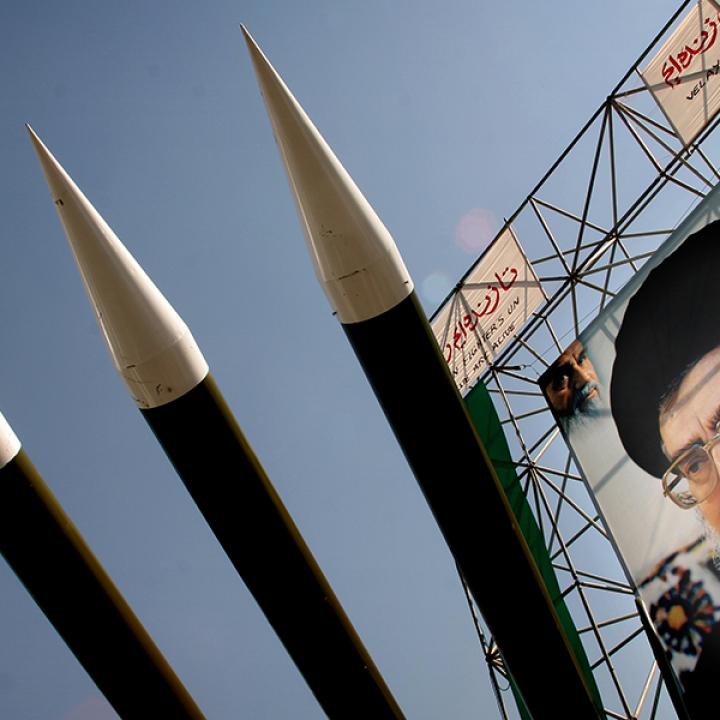

In line with his tendency to keep all options open when discussing nuclear negotiations, his latest speech gave only a yellow light to a potential deal.
On June 11, Iranian Supreme Leader Ali Khamenei delivered a speech before members of the country’s nuclear industry for the first time in years, against the backdrop of reports that Tehran and Washington have been indirectly negotiating a nuclear deal via Oman. As usual, he used the occasion to send implicit and explicit messages to domestic and foreign audiences alike, essentially setting boundaries for the government’s engagement with the United States and the International Atomic Energy Agency (IAEA).
Willing to accept a deal, but not any deal. Khamenei did not explicitly mention reviving the 2015 Joint Comprehensive Plan of Action (JCPOA). Instead, he talked about a vaguer “agreement,” asserting that there is no problem in reaching a new deal, but that it must meet certain conditions. In particular, he noted that Iran’s existing nuclear infrastructure must not be changed—a requirement that met with chants of “Allahu Akbar” from the audience. After the meeting, this same idea was emphasized in television remarks by Atomic Energy Organization of Iran (AEOI) spokesman Behrouz Kamalvandi and in Iranian newspapers. For example, the official government paper Iran included headlines such as “An Agreement That Keeps Nuclear Infrastructure” and “The Nuclear Infrastructure Must Be Kept.”
Cooperation with the IAEA should continue, but with limits. Khamenei argued that while Iran should maintain cooperation and communications with the IAEA, it should do so only in the framework of the agency’s existing Safeguards Agreement—in other words, the government should not consent to monitoring beyond that agreement. Referencing Tehran’s rocky relations with the agency, Khamenei reiterated his distrust of the nuclear watchdog and claimed that Iran should not fall under the burden of “coercive demands and false claims.” His comments followed criticism from IAEA director-general Rafael Grossi earlier this month regarding Iran’s implementation of a March deal with the agency.
The Supreme Leader also urged Iranian officials not to breach the parliament’s December 2020 “Strategic Action Plan to Lift Sanctions and Protect the Iranian Nation’s Interests” when giving access or information to the IAEA. This law called on the previous government to take substantial nuclear steps if international sanctions on the banking and oil sectors were not lifted, such as resuming uranium enrichment to 20 percent and limiting IAEA monitoring. In 2021, then-president Hassan Rouhani blamed this legislation for hindering attempts to revive the JCPOA. Last month, however, Khamenei declared that the law had “saved the country from confusion on the nuclear issue.”
The West cannot be trusted. Khamenei continued his longtime pattern of urging the government and the Iranian people to maintain their distrust of the “enemy.” He noted that twenty years of nuclear engagement had taught Iran whom it could trust and whom it could not. He lashed out at the IAEA and the parties to the JCPOA for allegedly not keeping their promises, and lamented that Iran had been harmed because it put too much trust in these actors.
Threats and pressure do not deter Iran. Khamenei reiterated that the West is trying to hinder Iran’s progress and humiliate the nation, sending a warning to “powerful countries” who believe that Iran is weak or helpless. In his view, the nuclear program’s continued progress is an “insult” to Westerners. And although he claimed that Iran still does not want to pursue nuclear weapons for religious reasons, he also declared that the West would not be able to prevent it if it decides to go that route.
The nuclear industry benefits the nation. A significant part of the speech was dedicated to explaining how Tehran’s nuclear achievements have improved the lives of the people in various sectors and elevated the nation’s honor. He called on the AEOI to continue developing the nuclear program in order to meet the goal of 20,000 megawatts of nuclear power—for comparison’s sake, the United States was generating 95,492 megawatts of nuclear power as of 2021, a rate that required ninety-three operating reactors. Khamenei even urged officials to commercialize nuclear products and services since they have “good demand in international markets.”
Hedging against a decision. In a May 20 speech before senior Foreign Ministry officials and ambassadors, Khamenei noted that Iran’s principles and flexibility go together, urging his audience not to engage in “imploring diplomacy.” He explained that his 2013 “heroic flexibility” speech—widely seen as a green light for negotiating with the United States—was misinterpreted, instead comparing flexibility to taqiyya (dissimulation), the practice of concealing one’s true intentions in order to achieve a goal. His June 11 remarks seemingly followed suit, maintaining the ambiguity of past speeches regarding nuclear negotiations while exhibiting the same balance between flexibility and principles—that is, allowing room for an agreement to be struck, but ensuring that his audience understands its limited scope.
Omer Carmi is a former visiting fellow at The Washington Institute.


